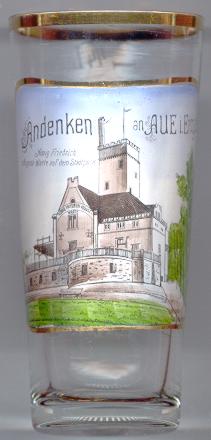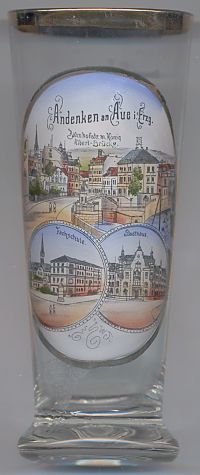

|
If you came to this page directly and do not see a navigation frame on top, please go to the home page.
| DEUTSCHLAND | GERMANY |
| Bundesland: Freistaat Sachsen | Saxony |
| Landkreis: Erzgebirgskreis |
 Aue is situated at an elevation of 350 m at the confluence of the river Schwarzwasser into the Freiberger Mulde in western Saxony,
about 22 km west of the administrative centre of the Erzgebirgskreis district, Annaberg-Buchholz, about 31 km southwest
of Chemnitz, and about 90 km southwest of Saxony's capital, Dresden.
The town has a population of about 16,000 (2017) and since 2019 is part of the municipality of Aue-Bad Schlehma.
Aue is situated at an elevation of 350 m at the confluence of the river Schwarzwasser into the Freiberger Mulde in western Saxony,
about 22 km west of the administrative centre of the Erzgebirgskreis district, Annaberg-Buchholz, about 31 km southwest
of Chemnitz, and about 90 km southwest of Saxony's capital, Dresden.
The town has a population of about 16,000 (2017) and since 2019 is part of the municipality of Aue-Bad Schlehma.
The earliest mention of Aue dates back to 1526. In 1627 it obtained the right to hold two annual fairs and in 1632 it
received the status of a free town. The town was completely destroyed in 1633 during the Thirty Years' War. Starting in
1698/1709, kaolin was mined in Aue and was used by Johann Friedrich Böttger to produce the first white china porcelain of Europe.
During the Seven Years' War Aue was again destroyed during a battle between Prussian and Austrian troops. The industrial development
was boosted by the opening of two railway lines through Aue in 1858 and 1875, respectively. After that, Aue developed into the most important
industrial site of the Erzgebirge (Ore Mountains) region. The village of Zelle, which already had been mentioned in a document of 1173, became part
of Aue in 1897. Since then the year 1173 is used for calculating anniversaries of Aue.
The districts Aue and Schwarzenberg were merged in 1994. Aue became the seat of the the new district,
which at first was named Westerzgebirgskreis. In 1995 the district was renamed Aue-Schwarzenberg. On 1st August 2008 the districts Annaberg,
Aue-Schwarzenberg, Mittlerer Erzgebirgskreis and Stollberg were merged to become the new district Erzgebirgskreis with the seat of the district's
administration in Annaberg-Buchholz. In 2019, the neighbouring municipalities of Aue and Bad Schlehma
were merged into the new municipality of Aue-Bad Schlehma.

The  Stadthaus ('Municipal House', i.e. the Town Hall) [left, no. 1902: top picture] was built in 1889/1890.
It was renovated after 1990.
Stadthaus ('Municipal House', i.e. the Town Hall) [left, no. 1902: top picture] was built in 1889/1890.
It was renovated after 1990.
The  König-Friedrich-August-Warte [left, no. 1902: bottom left picture, and right, no. 804] was planned
by citizens of Aue beginning in 1895.
The park was designed on an inclined area at the bank of the river Mulde. The municipality donated further land in 1902.
The lookout tower itself was built in 1904/1905 and was named for Friedrich August III, the last King of Saxony (b.1865, acc.1904, abd.1918,d.1932).
König-Friedrich-August-Warte [left, no. 1902: bottom left picture, and right, no. 804] was planned
by citizens of Aue beginning in 1895.
The park was designed on an inclined area at the bank of the river Mulde. The municipality donated further land in 1902.
The lookout tower itself was built in 1904/1905 and was named for Friedrich August III, the last King of Saxony (b.1865, acc.1904, abd.1918,d.1932).
The bottom right picture on glass no. 1902 [left] shows the
 King
King

The top picture on glass no. 2318 [left] shows a view of
 Bahnhofstraße
Bahnhofstraße König-Albert-Brücke
König-Albert-Brücke
The bottom left picture shows a view of the
 Fachschule
Fachschule
The bottom right picture shows a view of the Stadthaus (Municipal House, i.e. Town Hall), already described above.


The former  Sanatorium [near left, no. 0000: bottom left picture was founded
in 1893 as Privat-Anstalt in Aue von Dr. Pilling und Dr. Köhler and from 1907 operated under the name
Orthopädische und Wasser-Heilanstalt Dr. Pilling. The sanatorium was a sanatorium for the upper classes,
consisting of a main building and three smaller, individual villa-like buildings with machinery and heating systems. Pilling's
treatments included water, steam, mud and galvanic baths, gymnastic exercises to mobilize stiff joints, massages , diet and
recumbent treatments. After World War I and the subsequent inflation, fewer and fewer people came to the sanatorium. In 1924
the complex was sold to the Saxon Deaconess Community Association and the facility then operated under the name Erholungsheim
des Gemeinschaftsvereins im Freistaat Sachsen e.V. (Recreational Home of the Community Association in the Free State of Saxony).
This name reflects the fact that the sanatorium's services were continued in the form of a recreational home. During the Nazi period,
the facilities were used as a reserve military hospital. After World War II, the hospital closed, but re-opened in 1946 as
a children's hospital, which after 1933 was relocated to the Aue Clinic. The main building was thoroughly renovated by 1999 wit the
support of the Free State of Saxony. Today it operates as the Saxon Community Deaconess House 'Zion' in Aue, a social
institution within the Evangelical Lutheran Church of Saxony and a member of the Diakonisches Werk Sachsen.
Sanatorium [near left, no. 0000: bottom left picture was founded
in 1893 as Privat-Anstalt in Aue von Dr. Pilling und Dr. Köhler and from 1907 operated under the name
Orthopädische und Wasser-Heilanstalt Dr. Pilling. The sanatorium was a sanatorium for the upper classes,
consisting of a main building and three smaller, individual villa-like buildings with machinery and heating systems. Pilling's
treatments included water, steam, mud and galvanic baths, gymnastic exercises to mobilize stiff joints, massages , diet and
recumbent treatments. After World War I and the subsequent inflation, fewer and fewer people came to the sanatorium. In 1924
the complex was sold to the Saxon Deaconess Community Association and the facility then operated under the name Erholungsheim
des Gemeinschaftsvereins im Freistaat Sachsen e.V. (Recreational Home of the Community Association in the Free State of Saxony).
This name reflects the fact that the sanatorium's services were continued in the form of a recreational home. During the Nazi period,
the facilities were used as a reserve military hospital. After World War II, the hospital closed, but re-opened in 1946 as
a children's hospital, which after 1933 was relocated to the Aue Clinic. The main building was thoroughly renovated by 1999 wit the
support of the Free State of Saxony. Today it operates as the Saxon Community Deaconess House 'Zion' in Aue, a social
institution within the Evangelical Lutheran Church of Saxony and a member of the Diakonisches Werk Sachsen.
The bottom right picture shows a view of the Fachschule für Blechindustrie (technical scholl for sheet metal working),
already described above.
[https://de.wikipedia.org/wiki/Aue_(Sachsen), https://en.wikipedia.org/wiki/Aue,_Saxony;
https://de.wikipedia.org/wiki/Geschichte_der_Stadt_Aue;
https://de.wikipedia.org/wiki/Diakonissenhaus_Zion_(Aue)]
![[scale]](lineal.jpg)